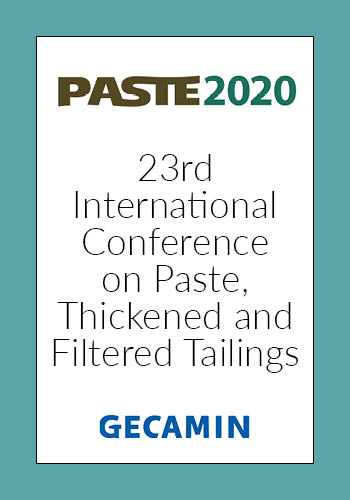Monitoring of Moisture Content in Paste Tailings using Hyperspectral Cameras

|
Authors: Sanchez, M; Araya, V; Suazo, G |
DOI https://doi.org/10.36487/ACG_repo/2052_105
Cite As:
Sanchez, M, Araya, V & Suazo, G 2020, 'Monitoring of Moisture Content in Paste Tailings using Hyperspectral Cameras ', in H Quelopana (ed.), Paste 2020: 23rd International Conference on Paste, Thickened and Filtered Tailings, Gecamin Publications, Santiago, https://doi.org/10.36487/ACG_repo/2052_105
Abstract:
Chile produces large amounts of tailings daily which must be safely disposed on the earth’s surface. There are a series of strategies that have been successfully used in our country to store tailings, among them are thickened and paste tailings. Paste tailings are an advantageous technique that allows for greater recovery of water while improving physical stability of the structure. Although challenges are faced worldwide when large production rates are tried to be thickened, the technique seems promising for countries like Chile where there is an ongoing water crisis. The stability of paste tailings facilities is highly influenced by water content or saturation. As consolidation occurs the tailings loses water. However, as the evaporation front takes place, the material goes from a saturated to a non-saturated state. Unsaturated paste has shown improved resistance, e.g. liquefaction resistance almost double when saturation drops below 90%. A well planned facility operation should consider the monitoring of the water content of the paste. However, this is sometimes difficult, due to the large areas that must be controlled and the danger associated with manual moisture measurements in the field. In this context, we proposed the use of hyperspectral cameras to obtain a relationship between the paste moisture content and light reflectance. This would allow to generate moisture surface map and to the use of this data to monitor for instance evaporation rates or water balance in tailings storage facilities. This article summarizes laboratory main findings and proposes a series of procedures to implement the technique in the field.
References:
Araya, V., Suazo, G., Villavicencio, G., and Silva, M. (2018) ‘Use of UAV and Satellite Images for the Monitoring of Water Content in Tailings Storage Facilities’, 5th International Seminar on Tailings Management, Santiago, Chile, 2018,10.
Hassan-Esfahani, L., Torres-Rua, A., Jensen, A., and Mckee, M. (2015) ‘Assessment of Surface Soil Moisture Using High-Resolution Multi-Spectral Imagery and Artificail Neural Networks’, Remote Sensing, 7(3),2627-2646.
Taktikou, E., Bourazanis, G., Papaioannou, G., and Kerkides, P. (2016) ‘Prediction of Soil Moisture from Remote Sensing Data’, Procedia Engineering, The Author(s),162,309-316.
© Copyright 2025, Australian Centre for Geomechanics (ACG), The University of Western Australia. All rights reserved.
View copyright/legal information
Please direct any queries or error reports to repository-acg@uwa.edu.au
View copyright/legal information
Please direct any queries or error reports to repository-acg@uwa.edu.au